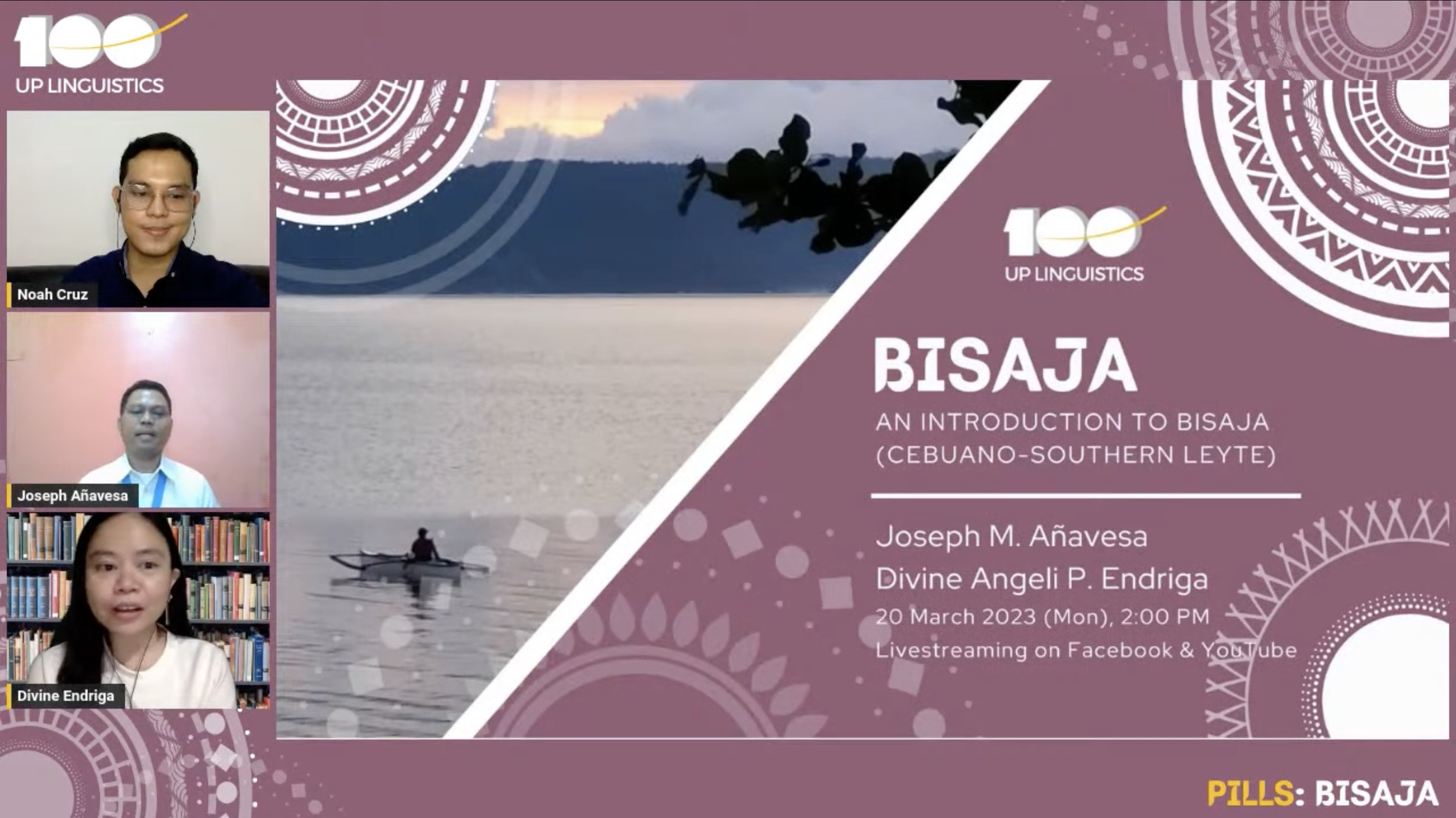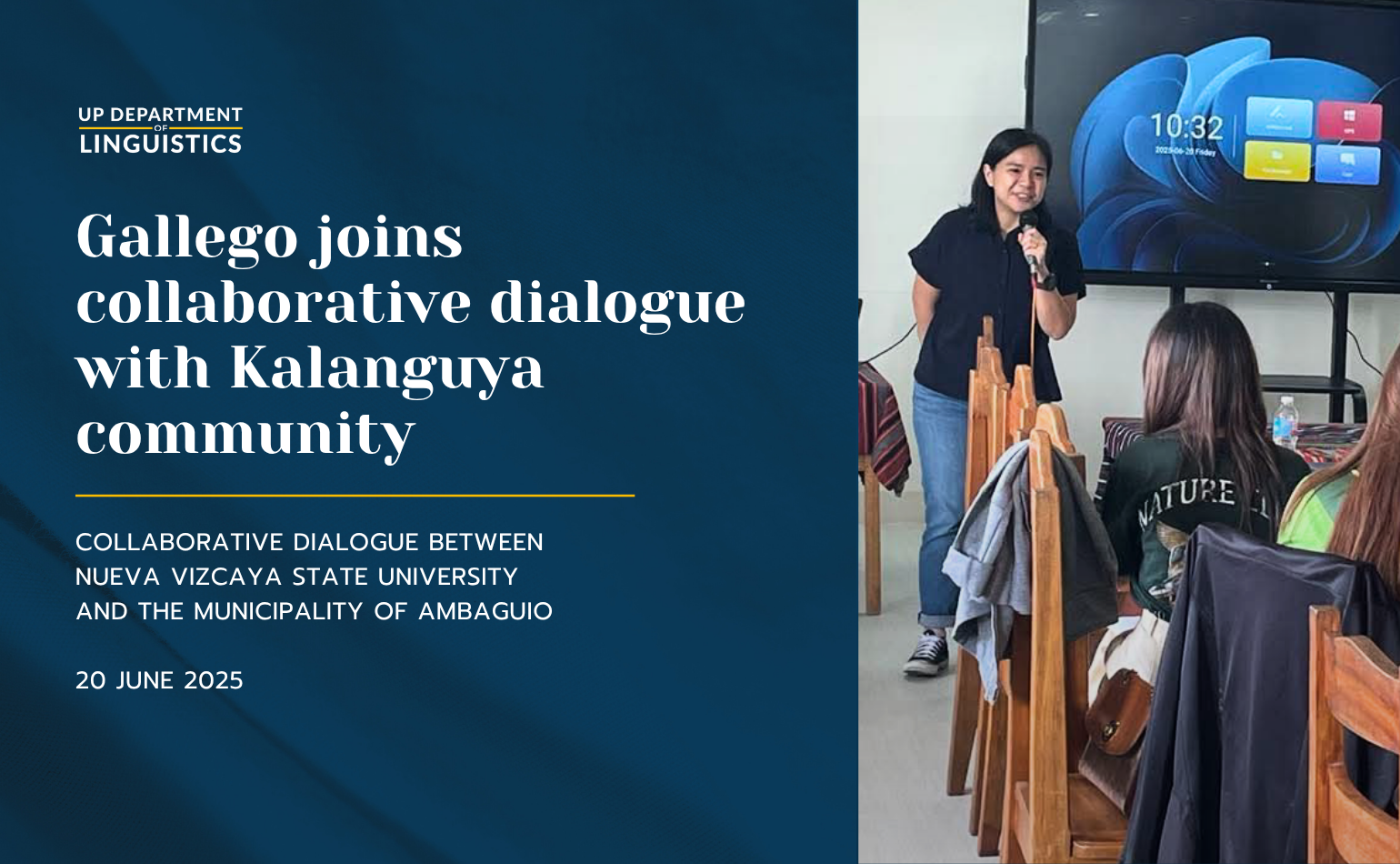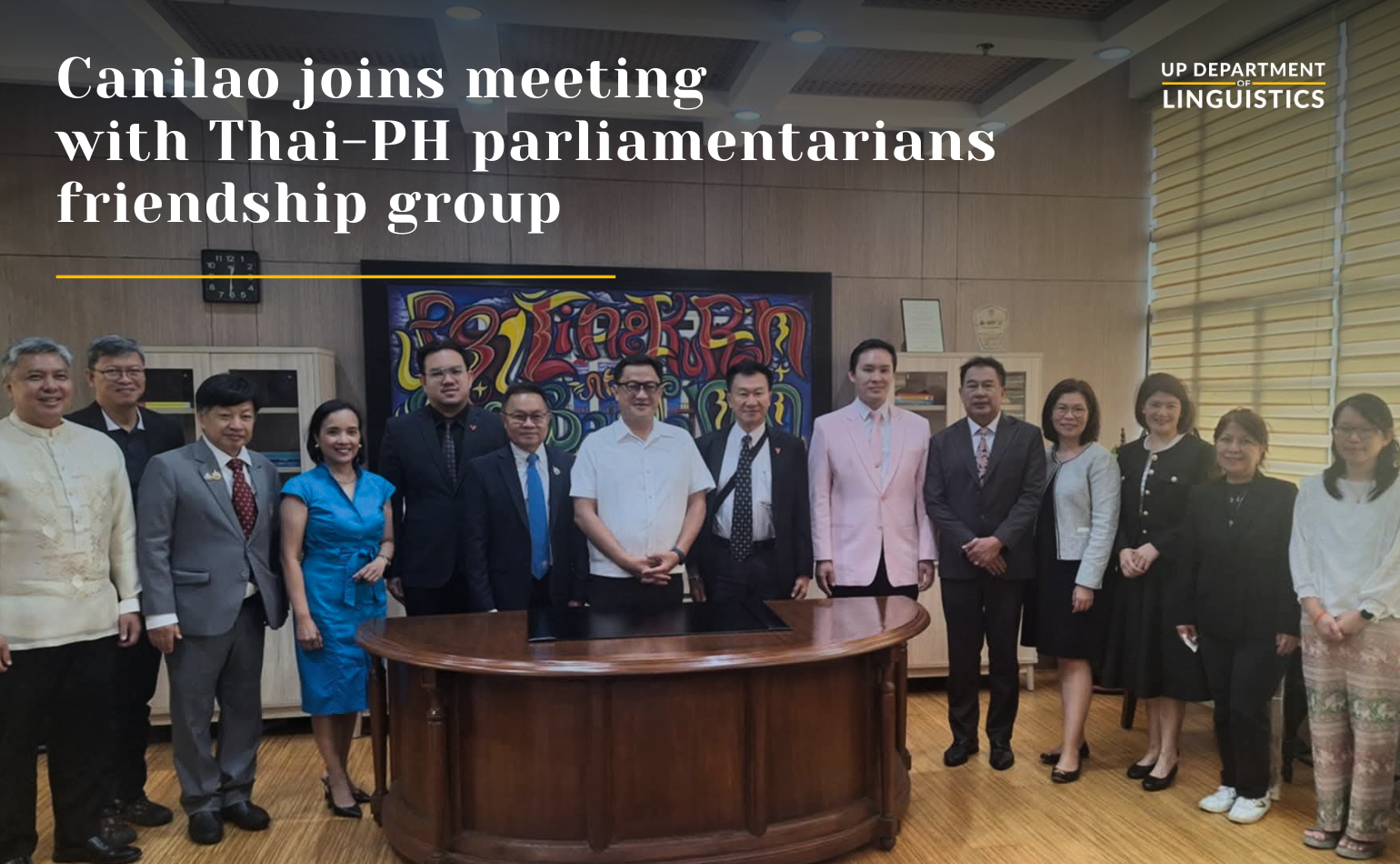
Lovers of Philippine languages gathered for an online lecture by Associate Professor Joseph M. Añavesa of Southern Leyte State University (Tomas Oppus Campus) and Assistant Professor Divine Angeli Endriga of the UP Diliman Department of Linguistics titled, “An Introduction to Bisaja (Cebuano-Southern Leyte)” on last March 20, 2023.
This lecture was the third installment of the Department’s ongoing Philippine Indigenous Languages Lecture Series (PILLS). For this session, Añavesa and Endriga did a preliminary description of the features of Bisaja, a variant of Cebuano spoken in Southern Leyte, Philippines. According to their abstract, while many studies had been published on Cebuano, such as Wolff (1962, 1965) and Bunye and Yap (1971a, 1971b), dialectological studies on the language were scarce. More importantly, there is currently no substantial published description available of the variety spoken in Southern Leyte. This lecture helped to address this gap.
Endriga began her description by first describing the area where Bisaja is spoken, Southern Leyte, which became a separate province in 1959. It had a population of approximately 420,000 as of the 2015 census and it is made up of 18 municipalities and one city – its capital, Maasin.
Endriga then dove straight into the structural features of Bisaja by providing a brief a phonological profile of the language. Bisaja, she said, is made up of 16 consonants: 7 stops, 3 nasals, 2 fricatives, 2 liquids, and 2 glides. They can occur in all word positions – initial, medial, and final – and the phonemes /l, r, w, j, s/ can occur in syllable-medial position as part of a consonant cluster.
“Most of these consonants are stable and do not undergo sound changes,” Endriga explained. The only exceptions to these are /l/ and /j/. In the case of /l/, a sound change occurs when it is deleted between the same vowel and compensatory lengthening occurs. For example, [‘dalan] ‘road’ becomes [ˈdaːn]. /l/ can also become [w] between [a] and [ʊ] as in the case of [‘balʊd] ‘wave’ becoming [‘bawʊd], and finally [‘bawd] with the deletion of [ʊ]. It can also become [w] between [ʊ] and [a], although this time the deletion of [ʊ] is optional, which will result in a consonant cluster in the onset position.
Also, in the town of San Juan, /l/ becomes [j] between the same vowel. “This change is influenced by Surigao,” Endriga noted. “The reason for this influence may be trade. Until today, some people still buy commodities and trade with Surigao,” she said, “And binabangka lang ito (they just go by boat).” Other proposed influences are migration and intermarriage.
Another change, this one being a “characteristic sound” of the Southern Leyte dialect is the change of [j] to the affricate [dʒ] in the syllable initial position. This can be seen in words like [ˈbagjʊ] ‘typhoon’ and [lʊˈja] ‘weak’ becoming [ˈbagdʒʊ] and [lʊˈdʒa], respectively. They have this in common with the dialect spoken in Bohol or Binul-anon.
In addition, Endriga said that Bisaja has three consonants: /ɪ/, /a/, and /ʊ/. These vowels do not occur in word initial positions. These three are the only phonemic (word differentiating) vowels, with /ɜ/ and/ɔ/ occurring in borrowed words and in certain environments only.
The vowel /ɪ/ is in free variation with both [i] and [ɜ], as seen when [pʊtiʔ] (white) can be pronounced as [pʊtɜʔ]. In similar fashion, /ʊ/ is also in free variation with [u] and /ɔ/, where the latter can usually replace /ʊ/ when it is the final segment of the word on in the ultima. When preceded by /w/, /a/ can be pronounced like [ɔ] or the schwa sound [ə]. This may be attributed, she said, to the influence of the lip rounding required to pronounce the bilabial /w/ sound. Lastly, the previously mentioned /ə/ sound was originally a part of proto-Visayan, though it has coalesced with /ʊ/ except in the barangays Amparo and Laray in Macrohon.
After this segment, Añavesa began his discussion of Bisaja’s suprasegmentals. In Bisaja, he said, stress is found in either the ultima or the penultima of a word. Also, stress is phonemic in Bisaja “because a change in stress is followed by a change in meaning”. For example, the different stresses in the words [ˈba.gaʔ] ‘lung’ and [ba.ˈgaʔ] ‘thick’ serve to distinguish them from one another.
Also, in Bisaja, we observe consonant clusters or series of consonants in the same syllable. Añavesa said these typically occur in the onset position before a vowel. An example of this (a stop + /w/) is the /pw/ in the word /pwɛdɛ/ ‘possible, okay’. Some of these clusters where a fricative or stop combines with /w/ can even be pronounced as consonant+ [ʊj-], as when /pwɛdɛ/ is pronounced as [pʊjdɛ].
Another type of cluster is made up of affricates like [tʃ] and [dʒ]. “The afficate [dʒ] is very productive in Bisaja,” Añavesa noted. “We prefer to call our dialect Bisaja (as opposed to Binisaya or Bisaya),” he said, because of this idiosyncrasy. Bisaja also features diphthongs, which are a combination of a vowel and a glide, namely: /aw/, /ɪw/, /aj/, and /ʊj/ or /ɔj/. These usually occur in the coda position, as in the words /ˈʔadlaw/ ‘day’ and /ˈʔagiw/ ‘soot.’ He then discussed the six different syllable patterns in Bisaja, led by the core syllable CV, but also including CVC, CVCC, CCV, CCVC, and CCVCC.
Finally, Añavesa presented some of what they believe to be unique usages to Bisaja, such as the use of the determiner ag ‘the,’ the use of the personal/possessive pronouns aho, naho, and kanaho; the use of the particle/interjection sii and others. He noted that both presenters talked about these unique usages and agreed to publish papers featuring them as there have been no in-depth studies on them to date.
The pair’s lecture was followed by a question and answer session, which saw them reveal the future directions their research might take, and comparisons to other dialects they might pursue.
The whole lecture on Bisaja can be viewed here. Stay tuned to the Department’s social media pages for more lectures and events.
Published by Andre Encarnacion



